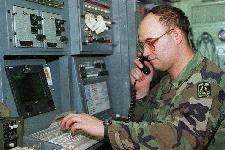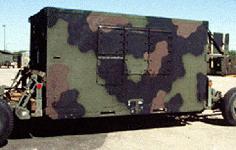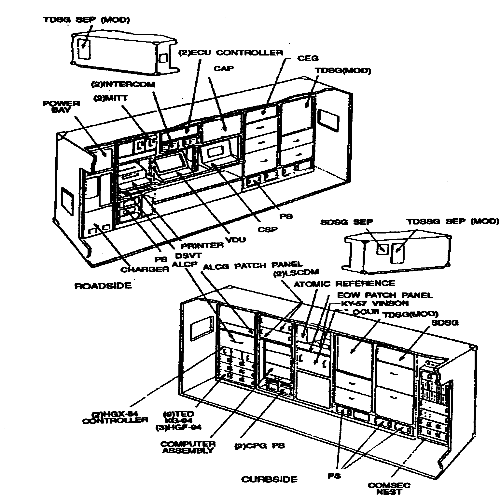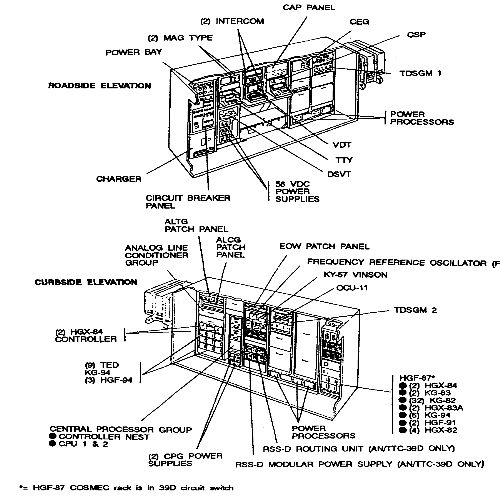


AN/TTC-39 TRI-TAC Automatic Telephone Central Office
The Tri-Service Tactical (TRI-TAC) signal system is a tactical command, control, and communications program. It is a joint service effort to develop and field advanced tactical and multichannel switched communications equipment The program was conceived to achieve
interoperability between service tactical communications systems, establish interoperability with strategic communications systems, take advantage of advances in technology, and eliminate duplication in service aquisitions. Each component of the program is assigned to one of the services to develop and aquire for the entire defense community. The major components assigned to the Army are the AN/TTC-39 family of voice switches and the AN/TYC-39 message switch, multichannel transmission equipment, and user voice and and message processing terminals and devices. To accomodate the need for a tactical communications system at Echelon Above Corps (EAC), HQ DA directed that heavy TRI-TAC components would operate at those command levels. This EAC structure is the essential link that facilitates and ensures timely, secure, two-way communications between strategic command authorities and their tactical fighting forces.
The AN/TTC-39A(V) is modular/transportable is a TRI-TAC switching communications and nodal control equipment that provides secure automatic switching and technical control for both digital and analog communications. It is a hybrid circuit switch, with a 744-line capacity (96 analog and 648 digital). The facility provides technical control functions including channel reassignment and multiplexing, line testing, engineering orderwire, atomic timing standard, and analysis or trouble reports, alarms, and system data. It signals and supervises analog and digital trunks and lines. This includes 20 Hz/1600 Hz ringdown, DC closure,
dial pulse, DTMF, and 6-wire E&M using tone burst, confirmation, non-confirmation, common channel, and digital in-band-trunk signaling (DIBITS).
The AN/TTC-39D is a modular and transportable nodal control mobile subscriber access circuit switch designed to provide secure and nonsecure automatic switching and technical control for analog, digital, and mobile subscriber traffic for the U.S. Army. The AN/TTC-39D is a product improvement of the AN/TTC-39A. The AN/TTC-39D is an all digital circuit switch with the capacity to terminate 712 lines (both analog and digital). The AN/TTC-39D also has flood search capability and is totally compatible/interchangeable with fielded Mobile Subscriber Equipment. The facility retains minumum essential technical control functions including channel reassignment, multiplexing, line testing, and engineering orderwire. The facility also retains minimum essential technical control functions for atomic timing standards, analysis of trouble reports, alarms, and system data.
There are two versions of the TTC-39 used in the European theater: the
39A(V)4, which is the USAF version, and the 39D, which is the US Army version. The
39A(V)4 normally runs at 32 Kbps, but can also be configured to run at 16 Kbps. The
Air Force switches use "deterministic" routing, which means that each destination and
each subscriber must be manually assigned in the database. The Army switches use the
"flood search" system, where each user affiliates their phone with a switch in the
network and the processor searches the network until the called destination is found.
The two are compatible but must be assigned in separate area codes.
An upgrade
program called CSR TEP will upgrade USAF switches to have flood search capability
and is scheduled for late 1996. The 39 has COMSEC USAF equipment which allows it
to provide secure loops and groups, key generation and storage, and act as a COMSEC
parent to the SB-3865. Thirty (30) Digital Transmission Groups (DTGs) can be run via
group modems at group rates from 128 Kbps to 460 Kbps, with channel rates of 16 or
32 Kbps. A switch that is configured to operate at 32 Kbps can run a DTG with a
channel rate of 16 Kbps, but the reverse is not true.
A total of 240 local telephone
subscribers can be provided, including secure digital phones, non-secure digital phones,
and STU-IIIs. Dialing is fully automatic and requires no operator assistance.
Programmable subscriber features include compressed dialing, call forwarding, and
conference calling. Accessories that come with the 39A(V)4 include the Remote Call
Service Position (RCSP) and the CV-4201 Line Termination Unit (LTU). The RSCP is
an operator console that can be located outside the van, eliminating the need for the
operator to be in the van at all times. The LTU is a 36 channel multiplexer that connects
to the 39 via an 1152 Kbps DTG. The LTU uses the same circuit cards as the 39 and
can terminate all of the same circuits, although it is specially wired to terminate the
6-wire NATO interface.
The AN/TTC-39A(V)4 contains two Time Division Switching Groups (TDSGM), an
Auxiliary Line Termination Group (ALTG), providing capacity for 240 local subscribers,
and 30 Group Modems. The circuits terminated can be a mixture of analog and digital
lines, depending on the card confuguration of the TDSGM and ALTG. All switching
within the switch is digital at a channel rate of 16 or 32 Kbps, depending on software
and hardware configuration. Line Termination Unit cards used with analog circuits
perform the analog to digital conversion for these circuits. The total number of
terminations to the switch is 712.




Sources and Resources
http://www.fas.org/man/dod-101/sys/land/an-ttc-39.htm
Maintained by Robert Sherman
Originally created by John Pike
Updated Saturday, January 09, 1999 12:56:38 PM










